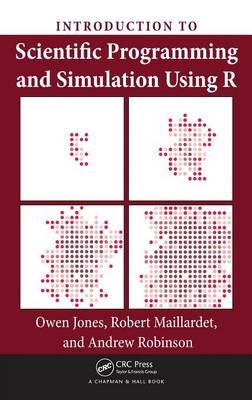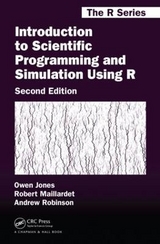
Introduction to Scientific Programming and Simulation Using R
Chapman & Hall/CRC (Verlag)
978-1-4200-6872-6 (ISBN)
- Titel erscheint in neuer Auflage
- Artikel merken
Known for its versatility, the free programming language R is widely used for statistical computing and graphics, but is also a fully functional programming language well suited to scientific programming.
An Introduction to Scientific Programming and Simulation Using R teaches the skills needed to perform scientific programming while also introducing stochastic modelling. Stochastic modelling in particular, and mathematical modelling in general, are intimately linked to scientific programming because the numerical techniques of scientific programming enable the practical application of mathematical models to real-world problems.
Following a natural progression that assumes no prior knowledge of programming or probability, the book is organised into four main sections:
Programming In R starts with how to obtain and install R (for Windows, MacOS, and Unix platforms), then tackles basic calculations and program flow, before progressing to function based programming, data structures, graphics, and object-oriented code
A Primer on Numerical Mathematics introduces concepts of numerical accuracy and program efficiency in the context of root-finding, integration, and optimization
A Self-contained Introduction to Probability Theory takes readers as far as the Weak Law of Large Numbers and the Central Limit Theorem, equipping them for point and interval estimation
Simulation teaches how to generate univariate random variables, do Monte-Carlo integration, and variance reduction techniques
In the last section, stochastic modelling is introduced using extensive case studies on epidemics, inventory management, and plant dispersal. A tried and tested pedagogic approach is employed throughout, with numerous examples, exercises, and a suite of practice projects. Unlike most guides to R, this volume is not about the application of statistical techniques, but rather shows how to turn algorithms into code. It is for those who want to make tools, not just use them.
University of Melbourne, Parkville, Australia
Part I: PROGRAMMING
Setting Up
Installing R
Starting R
Working Directory
Writing Scripts
Help
Supporting Material
R as a Calculating Environment
Arithmetic
Variables
Functions
Vectors
Missing data
Expressions and assignments
Logical expressions
Matrices
The workspace
Basic Programming
Introduction
Branching with if
Looping with for
Looping with while
Vector-based programming
Program flow
Basic debugging
Good programming habits
I/O: Input and Output
Text
Input from a file
Input from the keyboard
Output to a file
Plotting
Programming with Functions
Functions
Scope and its consequences
Optional arguments and default values
Vector-based programming using functions
Recursive programming
Debugging functions
Sophisticated Data Structures
Factors
Dataframes
Lists
The apply family
Better Graphics
Introduction
Graphics parameters: par
Graphical augmentation
Mathematical typesetting
Permanence
Grouped graphs: lattice
3D-plots
Pointers to Further Programming Techniques
Packages
Frames and environments
Debugging again
Object-oriented programming: S3
Object-oriented programming: S4
Compiled code
Further reading
Part II: NUMERICAL TECHNIQUES
Numerical Accuracy and Program Efficiency
Machine representation of numbers
Significant digits
Time
Loops versus vectors
Memory
Caveat
Root-Finding
Introduction
Fixed-point iteration
The Newton-Raphson method
The secant method
The bisection method
Numerical Integration
Trapezoidal rule
Simpson’s rule
Adaptive quadrature
Optimisation
Newton’s method for optimisation
The golden-section method
Multivariate optimisation
Steepest ascent
Newton’s method in higher dimensions
Optimisation in R and the wider world
A curve fitting example
Part III: PROBABILITY AND STATISTICS
Probability
The probability axioms
Conditional probability
Independence
The Law of Total Probability
Bayes’ theorem
Random Variables
Definition and distribution function
Discrete and continuous random variables
Empirical cdf’s and histograms
Expectation and finite approximations
Transformations
Variance and standard deviation
The Weak Law of Large Numbers
Discrete Random Variables
Discrete random variables in R
Bernoulli distribution
Geometric distribution
Negative binomial distribution
Poisson distribution
Continuous Random Variables
Continuous random variables in R
Uniform distribution 282
Lifetime models: exponential and Weibull
The Poisson process and the gamma distribution
Sampling distributions: normal, x2, and t
Parameter Estimation
Point Estimation
The Central Limit Theorem
Confidence intervals
Monte-Carlo confidence intervals
Part IV: SIMULATION
Simulation
Simulating iid uniform samples
Simulating discrete random variables
Inversion method for continuous rv
Rejection method for continuous rv
Simulating normals
Monte-Carlo Integration
Hit-and-miss method
(Improved) Monte-Carlo integration
Variance Reduction
Antithetic sampling
Importance sampling
Control variates
Case Studies
Introduction
Epidemics
Inventory
Seed dispersal
Student Projects
The level of a dam
Roulette
Buffon’s needle and cross
Insurance risk
Squash
Stock prices
Glossary of R commands
Programs and functions developed in the text
Index
| Erscheint lt. Verlag | 17.3.2009 |
|---|---|
| Reihe/Serie | Chapman & Hall/CRC: The R Series |
| Zusatzinfo | 500+; 4 Tables, black and white; 95 Illustrations, black and white |
| Sprache | englisch |
| Maße | 156 x 234 mm |
| Gewicht | 794 g |
| Themenwelt | Mathematik / Informatik ► Informatik ► Theorie / Studium |
| Naturwissenschaften | |
| ISBN-10 | 1-4200-6872-5 / 1420068725 |
| ISBN-13 | 978-1-4200-6872-6 / 9781420068726 |
| Zustand | Neuware |
| Informationen gemäß Produktsicherheitsverordnung (GPSR) | |
| Haben Sie eine Frage zum Produkt? |
aus dem Bereich



